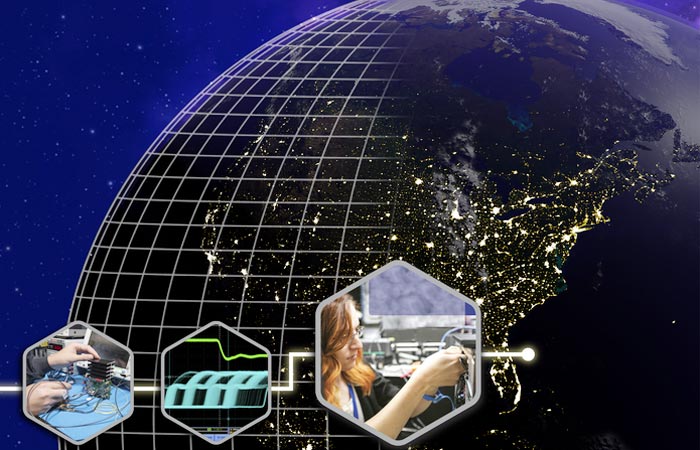Machine learning refines earthquake detection capabilities

An image showing improved detection of a slow earthquake in Turkey.
Credit: Los Alamos National Laboratory
New methodology enables the detection of ground deformation automatically at a global scale.
Researchers at Los Alamos National Laboratory are applying machine learning algorithms to help interpret massive amounts of ground deformation data collected with Interferometric Synthetic Aperture Radar (InSAR) satellites; the new algorithms will improve earthquake detection.
“Applying machine learning to InSAR data gives us a new way to understand the physics behind tectonic faults and earthquakes,” said Bertrand Rouet-Leduc, a geophysicist in Los Alamos’ Geophysics group. “That’s crucial to understanding the full spectrum of earthquake behavior.”
New satellites, such as the Sentinel 1 Satellite Constellation and the upcoming NISAR Satellite, are opening a new window into tectonic processes by allowing researchers to observe length and time scales that were not possible in the past. However, existing algorithms are not suited for the vast amount of InSAR data flowing in from these new satellites, and even more data will be available in the near future.
In order to process all of this data, the team at Los Alamos developed the first tool based on machine learning algorithms to extract ground deformation from InSAR data, which enables the detection of ground deformation automatically—without human intervention—at a global scale. Equipped with autonomous detection of deformation on faults, this tool can help close the gap in existing detection capabilities and form the foundations for a systematic exploration of the properties of active faults.
Systematically characterizing slip behavior on active faults is key to unraveling the physics of tectonic faulting, and will help researchers understand the interplay between slow earthquakes, which gently release stress, and fast earthquakes, which quickly release stress and can cause significant damage to surrounding communities.
The team’s new methodology enables the detection of ground deformation automatically at a global scale, with a much finer temporal resolution than existing approaches, and a detection threshold of a few millimeters. Previous detection thresholds were in the centimeter range.
In preliminary results of the approach, applied to data over the North Anatolian Fault, the method reaches two millimeter detection, revealing a slow earthquakes twice as extensive as previously recognized.
The results are detailed in the paper “Autonomous Extraction of Millimeter-scale Deformation in InSAR Time Series Using Deep Learning,” which was published in Nature Communications, DOI: 10.1038/s41467-021-26254-3
Funding: This work was funded through Los Alamos National Laboratory’s Laboratory Directed Research and Development Office.
About Los Alamos National Laboratory
Los Alamos National Laboratory, a multidisciplinary research institution engaged in strategic science on behalf of national security, is managed by Triad, a public service oriented, national security science organization equally owned by its three founding members: Battelle Memorial Institute (Battelle), the Texas A&M University System (TAMUS), and the Regents of the University of California (UC) for the Department of Energy’s National Nuclear Security Administration.
Los Alamos enhances national security by ensuring the safety and reliability of the U.S. nuclear stockpile, developing technologies to reduce threats from weapons of mass destruction, and solving problems related to energy, environment, infrastructure, health, and global security concerns.
‘LA-UR-21-31121’
Journal: Nature Communications
DOI: 10.1038/s41467-021-26254-3
Media Contact
Nicholas Njegomir
DOE/Los Alamos National Laboratory
njegomir@lanl.gov
Office: 505-665-9394
Original Source
https://discover.lanl.gov/news/releases/1110-machine-learning
All latest news from the category: Information Technology
Here you can find a summary of innovations in the fields of information and data processing and up-to-date developments on IT equipment and hardware.
This area covers topics such as IT services, IT architectures, IT management and telecommunications.
Newest articles

Innovative 3D printed scaffolds offer new hope for bone healing
Researchers at the Institute for Bioengineering of Catalonia have developed novel 3D printed PLA-CaP scaffolds that promote blood vessel formation, ensuring better healing and regeneration of bone tissue. Bone is…

The surprising role of gut infection in Alzheimer’s disease
ASU- and Banner Alzheimer’s Institute-led study implicates link between a common virus and the disease, which travels from the gut to the brain and may be a target for antiviral…

Molecular gardening: New enzymes discovered for protein modification pruning
How deubiquitinases USP53 and USP54 cleave long polyubiquitin chains and how the former is linked to liver disease in children. Deubiquitinases (DUBs) are enzymes used by cells to trim protein…



